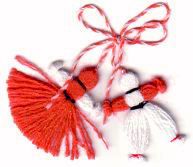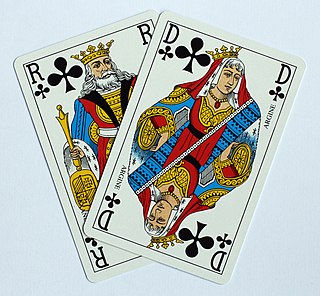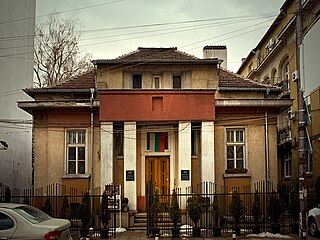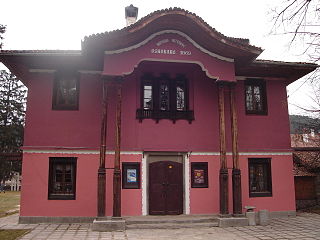 W
WA number of ancient civilizations, including the Thracians, Ancient Greeks, Scythians, Celts, Ancient Romans, Goths, Slavs, Varangians and the Bulgars have left their mark on the culture, history and heritage of Bulgaria. Due to this great variety of influences, Bulgaria has adopted many unusual traditions. Thracian artifacts include numerous temples, tombs, golden treasures and ancient rites and rituals, while ancient Bulgars have left traces of their heritage in statehood, early architecture, music and dances. Thracian rituals such as the Tryphon Zarezan which is dedicated to Saint Tryphon of Campsada, Kukeri and Martenitza are to this day kept alive in the modern Bulgarian culture. The oldest treasure of worked gold in the world, dating back to the 5th millennium BC, comes from the site of the Varna Necropolis.
 W
WGrandma Marta Day is a holiday celebrated in Bulgaria, on March 1. Martenitsas, usually in the form of a wrist band, small yarn dolls, or tassels, are created by combining red and white colored threads and are worn on that day and throughout March. They are worn until a stork or a swallow is seen, symbolizing the coming of spring, warmer weather, and well-being. Once the stork or a swallow appears the Martenitsa is taken off and hung on a blooming tree. It is common in the spring to see trees festooned in Martenitsas.
 W
WBelote is a 32-card, trick-taking, Ace-Ten game played primarily in France and certain European countries, namely Armenia, Bulgaria, Croatia, Cyprus, Greece, Luxembourg, Moldova, North Macedonia and also in Saudi Arabia. It is one of the most popular card games in those countries, and the national card game of France, both casually and in gambling. It was invented around 1920 in France, and is a close relative of both Klaberjass and Klaverjas. Closely related games are played throughout the world. Definitive rules of the game were first published in 1921.
 W
WThe Bulgarian Cultural Club – Skopje is a non-governmental organization in the Republic of North Macedonia established on 4 May 2008, and registered on 22 May 2008. Its executive board is chaired by Lazar Mladenov. The organization has local branches in Štip, Bitola, and other cities.
 W
WBulgarian National Film Archive also known as Bulgarian Cinematheque is an organization formed to acquire, restore, preserve and store film and film related archival artefacts of the national and world culture. Since 1959 it is a Member of the International Federation of Film Archives.
 W
WThe Bulgarian National Revival, sometimes called the Bulgarian Renaissance, was a period of socio-economic development and national integration among Bulgarian people under Ottoman rule. It is commonly accepted to have started with the historical book, Istoriya Slavyanobolgarskaya, written in 1762 by Paisius, a Bulgarian monk of the Hilandar monastery at Mount Athos, lead to the National awakening of Bulgaria and the modern Bulgarian nationalism, and lasted until the Liberation of Bulgaria in 1878 as a result of the Russo-Turkish War of 1877-78.
 W
WChiprovtsi kilims are handmade flatwoven kilim rugs with two identical sides, part of Bulgarian national heritage, traditions, arts and crafts and pertain to the Western Bulgarian kilim weaving tradition. Their name is derived from the town of Chiprovtsi where their production started in the 17th century.
 W
WA chitalishte is a typical Bulgarian public institution and building that fulfills several functions at once, such as a community centre, library, and a theatre. It is also used as an educational institution, where people of all ages can enroll in foreign language, dance, music and other courses. In this function they could be compared to the folk high schools of Northern Europe. Some larger urban chitalishta are comparable to 92nd Street Y in New York City.
 W
WThe Day of Bulgarian Alphabet, Bulgarian Enlightenment and Culture has been celebrated in Bulgaria since 11 May 1851. Today, this holiday is celebrated every year on May 24th and is an official holiday of Bulgaria since 1990. In 2020, the name was changed to Day of the holy brothers Cyril and Methodius, of the Bulgarian alphabet, education and culture and of Slavic literature.
 W
WThe International Chamber Music Festival in Plovdiv was founded in 1964 by a group of music enthusiasts, with the support of the Plovdiv Municipality and the Ministry of Culture.
 W
WJuly Morning is an annual Bulgarian festival, celebrated on the night before and the first day of July. The festival is unique to Bulgaria but it is not universally observed in the country.
 W
WKoprivshtitsa is a historic town in the Koprivshtitsa Municipality in Sofia Province, central Bulgaria, lying on the Topolnitsa River among the Sredna Gora mountains. It was one of the centres of the April uprising in 1876 and is known for its authentic Bulgarian architecture and for its folk music festivals, making it a tourist destination.
 W
WThe United Nations Educational, Scientific and Cultural Organization (UNESCO) designates World Heritage Sites of outstanding universal value to cultural or natural heritage which have been nominated by countries which are signatories to the UNESCO World Heritage Convention, established in 1972. Cultural heritage consists of monuments, groups of buildings, and sites. Natural features, geological and physiographical formations, and natural sites which are important from the point of view of science, conservation or natural beauty, are defined as natural heritage. Bulgaria accepted the convention on 7 March 1974.
 W
WThe medieval Bulgarian royal charters are some of the few surviving secular documents of the Second Bulgarian Empire, and were issued by five tsars roughly between 1230 and 1380. The charters are written in Middle Bulgarian using the Early Cyrillic alphabet.
 W
WThe National Palace of Culture, located in Sofia, the capital of Bulgaria, is the largest, multifunctional conference and exhibition centre in south-eastern Europe. It was opened in 1981 in celebration of Bulgaria's 1300th anniversary.
 W
WPig slaughter is the work of slaughtering domestic pigs which is both a common economic activity as well as a traditional feast in some European and Asian countries.
 W
WThe Seven Apostles are seven saints worshiped by Bulgarian Orthodox Church since the Middle ages. They are worshiped also by other Churches as the creator and distributor of the Glagolitic and Cyrillic script. These Saints are Saint Cyril and Methodius who created the Glagolitic script and their five students Kliment, Naum, Gorazd, Sava and Angelariy. Although Constantine of Preslav is considered a direct disciple of Methodius, the church traditionally did not include him because he was not canonized. In Russian Orthodox Church Saint Cyril and Methodius are separately celebrated and their disciples are recognized as Equal-to-apoties. Bulgarian Orthodox Church has decided July 27 as the day of the Assumption of Clement of Ohrid and the day of the Seven Saints.
 W
WThe Architecture of the Tarnovo Artistic School is a term for the development of architecture during the Second Bulgarian Empire (1185–1396). In the 13th and 14th centuries the capital Tarnovo determined the progress of the Bulgarian architecture with many edifices preserved or reconstructed which show the skills of the Medieval Bulgarian architects and the construction and decorative techniques they used. The builders have created a unique architectural style, known as Tarnovian Style, that influenced the architecture in many countries of Southeastern Europe and parts of Central Europe. With its diverse architecture, the Tarnovo School may be separated into several branches according to the function of the buildings.
 W
WUnification Day on 6 September is a national holiday of Bulgaria. It commemorates the unification of Eastern Rumelia and Bulgaria in 1885.
 W
WVechornytsi are Slavic traditional gatherings with music, songs, jokes and rituals. Vechornytsi traditionally began in late September after the seasonal agricultural work was over. Young people from villages gathered in the evenings for entertainment. There were everyday and festive vechornytsi. During everyday parties people created folk art objects like rushnyky, while entertaining themselves by singing songs or telling jokes. During festive vechornytsi rich dinners were cooked, and there was music and dancing. It was the ladies' responsibility to cook a dinner and the men's responsibility to provide everybody with music, drinks, and sweets.